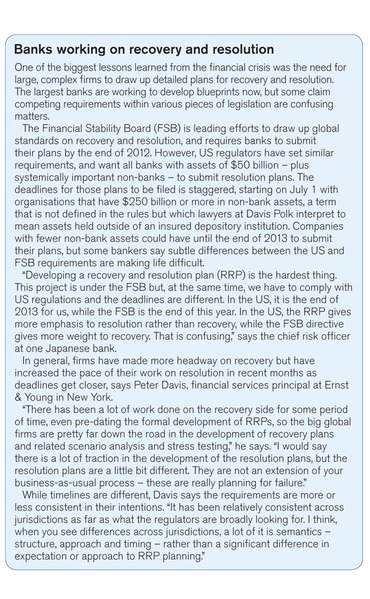
Managing the regulatory patchwork to ensure global consistency
Meanwhile, HR 3283 is meant to limit the extraterritorial reach of Dodd-Frank by clarifying the definition of a US person and non-US person. Specifically, the bill states that trades conducted between US swap dealers, or swap dealers with a US parent, and non-US entities that aren’t registered as swap dealers – which includes any agency or branch of a US entity located outside the US – would not be subject to Dodd-Frank. Any trade between the swap dealer and a US or non-US subsidiary, branch or affiliate of that dealer would also not be covered. In addition, it stipulates that a non-US entity that registers as a swap dealer will only need to comply with Dodd-Frank if it trades with a US entity (unless that entity is a US subsidiary, branch or affiliate of the non-US swap dealer).
However, there is no guarantee these bills will make it through Congress. At the time of going to press, both bills had been passed by the House Committee on Financial Services, but still need to be considered by the House of Representatives, as well as the Senate, in order to become law.
But while US legislators are looking to ditch some of the more contentious – and unique – elements of Dodd-Frank, global regulators appear to be moving towards the US position in other areas. Margin requirements on uncleared swaps are one example. US prudential regulators were on their own when they proposed these rules in April 2011, and US banks complained their extraterritorial reach would put them at a severe competitive disadvantage overseas. Now, a group comprising the Basel Committee on Banking Supervision, the International Organization of Securities Commissions, the Committee on Payment and Settlement Systems and the Committee on the Global Financial System are working to develop a global set of standards, potentially creating a more level playing field (Risk May 2012, pages 16–20).
“There is a degree of convergence. The similarities between different regulatory proposals are greater than the differences. Certainly, for the major markets, there is a broad consensus,” says Richard Metcalfe, head of global policy and a senior regulatory adviser at Isda in London.
Perhaps surprisingly, that might include the Volcker rule. While no directly comparable standard has been proposed elsewhere, there are signs other regulators are looking to do something similar. This includes the Independent Commission on Banking (ICB) – a group set up by UK chancellor of the exchequer George Osborne to propose ways of improving the stability of the UK banking system, and chaired by John Vickers (Risk October 2011, pages 70–72). In its final report, published in September 2011, the ICB recommended the ring-fencing of retail banking operations to ensure certain crucial banking functions, such as payments services, retail deposits and lending to small and medium-sized enterprises, are carved out from the rest of the group and placed in separate legal entities with their own capital requirement. Some argue this has similar intentions to the Volcker rule.
“Both are aimed at achieving the same thing: making sure the costs of bank resolution at the point of non-viability are minimised. But they are coming at it in different ways. Vickers is saying a bank can engage in this riskier activity, but only outside the ring fence; Volker is saying you can’t do it at all,” says Simon Hills, executive director for prudential capital, risk and regulatory relationships at the British Bankers’ Association in London (see box, Banks working on recovery and resolution).

Others agree. “Vickers addresses some of the same considerations that are in Volcker – of too big to fail, moral risk and conflicts of interest. Those issues can be addressed in different ways. Volcker is really one way of looking at it; Vickers is another,” says Eric Litvack, chief operating officer of global equity flow at Société Générale Corporate and Investment Banking, and an Isda board member.
Something similar could be under way in the European Union (EU), too. The European Commission has set up a group led by Erkki Liikanen, governor of the Bank of Finland, to consider whether structural reforms of EU banks are necessary to strengthen financial stability and improve consumer protection. The group should finish its work in the third quarter of this year, and many participants expect it to suggest something akin to the ICB. “What the Liikanen group will come up with will probably be yet another way of looking at the issue addressed by Vickers and Volcker,” says Litvack.
These measures are unlikely to slot together neatly – but they do signal a realisation by national regulators that they need to consider the bigger picture, say bankers. “If someone comes out with regulations that are too far away from the spirit of the G-20 commitments, it will appear as possibly facilitating regulatory arbitrage,” says Nitin Gulabani, global head of foreign exchange rates and credit at Standard Chartered, and an Isda board member.
Time is short, however. Much of the Dodd-Frank Act is supposed to be implemented this year, but some of the key rule-makings have yet to be finalised by US regulators (see table A). Meanwhile, the European Market Infrastructure Regulation (Emir) is meant to come into effect from 2013 – even though the final text was only agreed in February and approved by the European Parliament at the end of March. The European Securities and Markets Authority now has to draw up a number of technical standards required by Emir by September (see table B for a summary of the key technical standards). That doesn’t leave a huge amount of time to ensure a smooth, globally consistent framework, say bankers.
The timeline for the Volcker rule looks to be a little longer, though. Several US regulators now concede the July 21 deadline is unlikely to be met. “We’re working away and we’ll get it finished as fast as we can, but we’re unlikely to get it finished by the deadline,” says Walsh at the OCC.
Dealers welcome the fact that US regulators are willing to take longer to finalise this particular rule, but argue this recognition should have come at a much earlier point. “It gives all market participants a lot of comfort that regulators are listening to each other and to market participants. Many senior officials have now openly stated that the Volcker rule needs to be reworked, which shows how this dialogue is having an impact. In an ideal world, this would have happened at an earlier stage in the process and without triggering a market reaction,” says Shirvani at Credit Suisse.
Only users who have a paid subscription or are part of a corporate subscription are able to print or copy content.
To access these options, along with all other subscription benefits, please contact info@risk.net or view our subscription options here: http://subscriptions.risk.net/subscribe
You are currently unable to print this content. Please contact info@risk.net to find out more.
You are currently unable to copy this content. Please contact info@risk.net to find out more.
Copyright Infopro Digital Limited. All rights reserved.
As outlined in our terms and conditions, https://www.infopro-digital.com/terms-and-conditions/subscriptions/ (point 2.4), printing is limited to a single copy.
If you would like to purchase additional rights please email info@risk.net
Copyright Infopro Digital Limited. All rights reserved.
You may share this content using our article tools. As outlined in our terms and conditions, https://www.infopro-digital.com/terms-and-conditions/subscriptions/ (clause 2.4), an Authorised User may only make one copy of the materials for their own personal use. You must also comply with the restrictions in clause 2.5.
If you would like to purchase additional rights please email info@risk.net
More on Regulation
BoE’s Ramsden defends UK’s ring-fencing regime
Deputy governor also says regulatory reform is coming to the UK gilt repo market
Credit spread risk: the cryptic peril on bank balance sheets
Some bankers fear EU regulatory push on CSRBB has done little to improve risk management
Credit spread risk approach differs among EU banks, survey finds
KPMG survey of more than 90 banks reveals disagreement on how to treat liabilities and loans
Bowman’s Fed may limp on by after cuts
New vice-chair seeks efficiency, but staff clear-out could hamper functions, say former regulators
Review of 2025: It’s the end of the world, and it feels fine
Markets proved resilient as Trump redefined US policies – but questions are piling up about 2026 and beyond
Hong Kong derivatives regime could drive more offshore booking
Industry warns new capital requirements for securities firms are higher than other jurisdictions
Will Iosco’s guidance solve pre-hedging puzzle?
Buy-siders doubt consent requirement will remove long-standing concerns
Responsible AI is about payoffs as much as principles
How one firm cut loan processing times and improved fraud detection without compromising on governance







